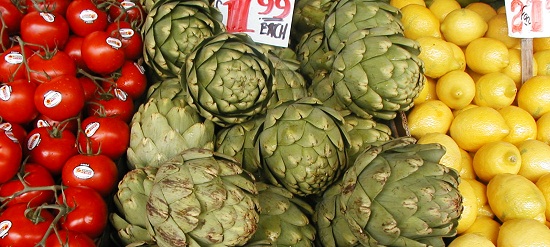I mentioned yesterday that my weekend cooking plans got derailed a bit. Saturday afternoon, I was in no mood to make a main dish and a dessert from new-to-me recipes. (My mind was to focused on the paper I needed to finish writing to do justice to a recipe on a page.) The ingredients would hold another day, so I went to a backup plan: Artichokes, grilled chicken breasts and salad. (Actually, there was also a very-last-minute backup-backup plan, because we discovered we were out of propane for our gas grill, so Jeff broiled the chicken breasts instead.)
Anyway, back to the artichokes. I think artichokes can seem complicated, if you’ve never cooked them, and especially if you’ve never eaten them, but they are really quite easy. You do a minor bit of quick prep work, get them cooking, then walk away for 45 minutes or so. Perfect for when you’re busy, but at home. Here’s how I cook them:
- Get out a pot with a lid that’s big enough to hold your artichokes, height and width-wide. It’s OK if the chokes lightly touch, but you don’t want to have to shoehorn them into the pot.
- Add about 1 inch of water to the pot. Add about a dozen whole peppercorns, a bay leaf and a few squeezes of lemon and/or dashes of white wine vinegar. Turn the heat to high.
- Use a sturdy knife to cut off the artichoke stems at the base, so that the chokes will sit nice and flat. If there are teeny leaves at the base or slightly down on the stem, make the trim job easier by removing those first (they aren’t good leaves for eating, anyway).
- When the water in the pot starts to come to a boil, turn the heat down to bring it to a simmer. Put the artichokes in the pot and cover with the lid.
Depending on how big your chokes are,they will take 45-60 minutes to cook. Testing for doneness is not my favorite part, because I sometimes miss the mark.
- What you’re aiming for is for the “meat” on the lower part of the leaves to be tender enough to scrape off with your teeth, but not so tender that it’s mushy.
- At the 45 minute mark, I use sturdy tongs to lift one of the chokes from the water, turn it over gently so any excess water drips off into the pan and not down my arm, and pierce the bottom with a fork or a knife.
- If it doesn’t penetrate easily, the chokes definitely need more time.
- If it does penetrate well, I pull off one of the lower leaves, let it cool for a few seconds, then to an experimental teeth scrape test.
- If it passes, they’re done, and I remove them from the water to a plate.
- If the leaf meat seems pretty tough, I put the choke back and check again in 10 minutes or so.
You can serve artichokes hot, at room temperature, or even the next day after refrigerating them overnight (take them out an hour before serving so they aren’t ice cold). This makes them quite versatile! Growing up, we always ate them hot, so the first time I saw my mother-in-law serving them cold, I thought, “Weird!” But they were great, so there you go.
Also, when I was growing up (we lived in California, which is like the artichoke capital of the U.S., if not the world, and they were one of my absolute favorite vegetables), everyone in my family ate them with melted butter for dipping…except for my Dad, who dipped them in mayonnaise, which I thought was gross and disgusting. I’ve since changed my tune.
Now, my standard household artichoke dipping sauce is made thusly: Equal parts good-quality mayo and nonfat Greek yogurt, stirred together with a touch of Dijon mustard, lemon juice and salt and pepper. If I’m making it, I’ll stir in a small spoonful of capers for extra flavor, and omit the salt.
So…how to you wrangle one of these things at the dinner table? First, you’ll need a bowl in which to discard the leaves as you eat the “meat” off them. We always do a communal bowl in the middle of the table (makes it easier when you need to dump them in the yard waste or compost bin). Then:
- Pull off a leaf. Look at the side that was up against the choke. The “meat” is on that side of the leaf, from the bottom (where it was attached) to about 1/3 to 1/2 of the way up the leaf, depending on how “meaty” it is.
- Dip the formerly attached end into the sauce (you usually just need a little…don’t scoop!).
- Bring the leaf up to your mouth and insert it halfway. Bite down lightly but firmly, and pull the leaf out of your mouth, scraping the flesh off with your top front teeth as you go.
- Discard the leaf.
- Continue plucking off leaves and eating them until the top of the artichoke looks very cone-shaped, and the leaves are getting pretty flimsy. Then you are ready to eat the best part…the artichoke heart!
- The heart is about a half-inch thick at the base of the artichoke. To separate it from the remaining leaves, repeatedly stick the tines of a fork between the heart and the base of the leaf cone, working your way around the whole artichoke. Then you sort of pry the cone off.
- If you look at the underside of the cone, you’ll see fibery strands (which turn into thistle-like petals if the artichoke is allowed to bloom). There will also be a dome of fibers still attached to the heart. Use a dinner knife to kind of scrape those off into the bowl.
- Then cut the heart into wedges, dip into the sauce, and enjoy!









